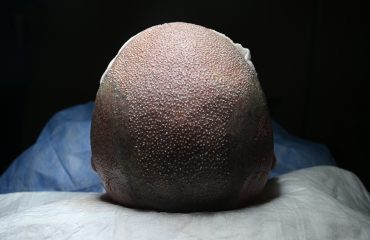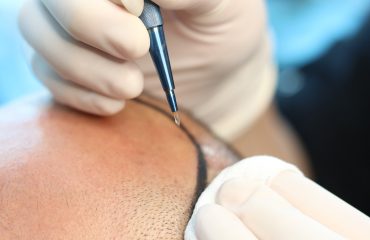Sapphire Fue
The abbreviation "FUE" stands for "Follicular Unit Extraction". In German, this can be translated as "removal of follicular units". These units are areas that contain a few hairs (about one to five on average). Such groupings occur naturally, and the term “grafts” is also commonly used for this in English jargon. In the FUE technique, these are removed as a whole. This has a decisive advantage: the hair is transplanted in its original arrangement, which provides a particularly natural result.



In concrete terms, the procedure is as follows: The doctor treating you removes the units from a predetermined donor site. This is an area of high hair density, usually at the back of the head. In our practice, we also offer patients the removal of body hair for scalp transplantation. However, it should be noted that the structure and color of the hair obtained in this way can differ from the rest. The doctor therefore makes an individual assessment of which site is used for the donation.
The removal itself is carried out with a hollow needle, so that grafts with a diameter of up to one millimeter are available. These are then stored in a special solution until they are used on the head. The incisions required for this are very small so that they do not have to be sewn up. The fine wounds are usually closed on the same day. Even if minimal scars remain, these are later hardly or not at all visible to the eye.
A variation of the manual FUE technique is the intervention with a micromotor. The surgeon does not guide the needle himself, but has it driven by a motor. This shortens the time of the procedure, so that treatment is possible in a single session. Another advantage is that the doctor can fully concentrate on selecting suitable grafts at the right angle.
FUE TECHNIQUE – FUE METHOD
Here, the hair roots are removed individually from the donor area with a micromotor and transplanted individually in the direction of growth into the channels provided for this purpose. The number of healthy and strong grafts that can be removed is analyzed in advance. The size of the area to be transplanted is also determined and whether the grafts are sufficient to cover the area. The patient discusses the expectation of the hair transplant with the doctor and then clarifies whether a hair transplant is an option. Once it has been finally decided whether a hair transplant is to be carried out, the hairline is determined and a plan is drawn up as to how many grafts are to be transplanted into which regions. FUE hair transplantation is performed under local anesthesia and the procedure takes about 6-10 hours for 2000-4500 grafts.
MEASURES BEFORE HAIR TRANSPLANTATION
One week before the treatment, no more anticoagulant medication should be taken, such as aspirin, vitamin E preparations.
Hair care products should not be used on the day of surgery. You should not smoke or drink alcohol for a week beforehand. On the day of the hair transplant, you should have a good breakfast before the operation.
Comfortable clothing is recommended.
FEATURES OF FUE HAIR TRANSPLANTATION
- Seam Free
- No scalpel is used
- Scar-free surgery
- It is performed with local anesthesia and the patient's sensation of pain is minimal.
- Fast Healing
- After the procedure, you can return to your everyday life.
- Natural Looking
THE TIME AFTER THE PROCEDURE
Although hair transplantation is basically a medical procedure, thanks to the gentle method, the consequences are far less serious than with other methods. The small wounds caused by removal and insertion are usually closed again on the first day. Since living hair roots are transplanted in this procedure, patients have to wait a certain amount of time after the procedure until the result is visible - after all, hair grows slowly. After about two months, the results are clearly visible. The final result can be seen after about a year. A note: If hair falls out a few weeks after the treatment, this is not a sign that the procedure was unsuccessful. This reaction is normal and means that the old hairs are now being replaced by new ones.
Even if patients should of course allow themselves rest after the treatment (a refusal to exercise is recommended in the first few weeks), "symptoms of illness" usually remain absent. Most of those treated are fit for work again the very next day.
